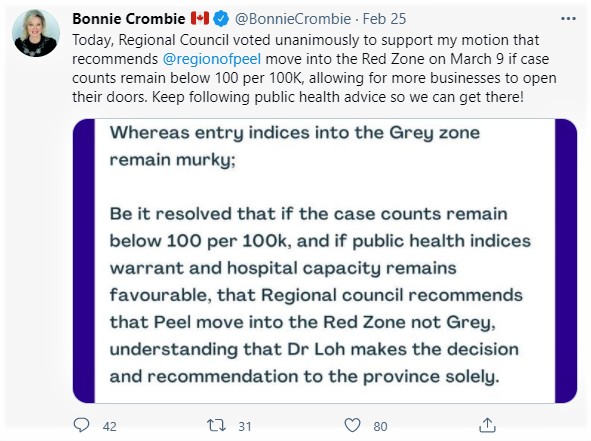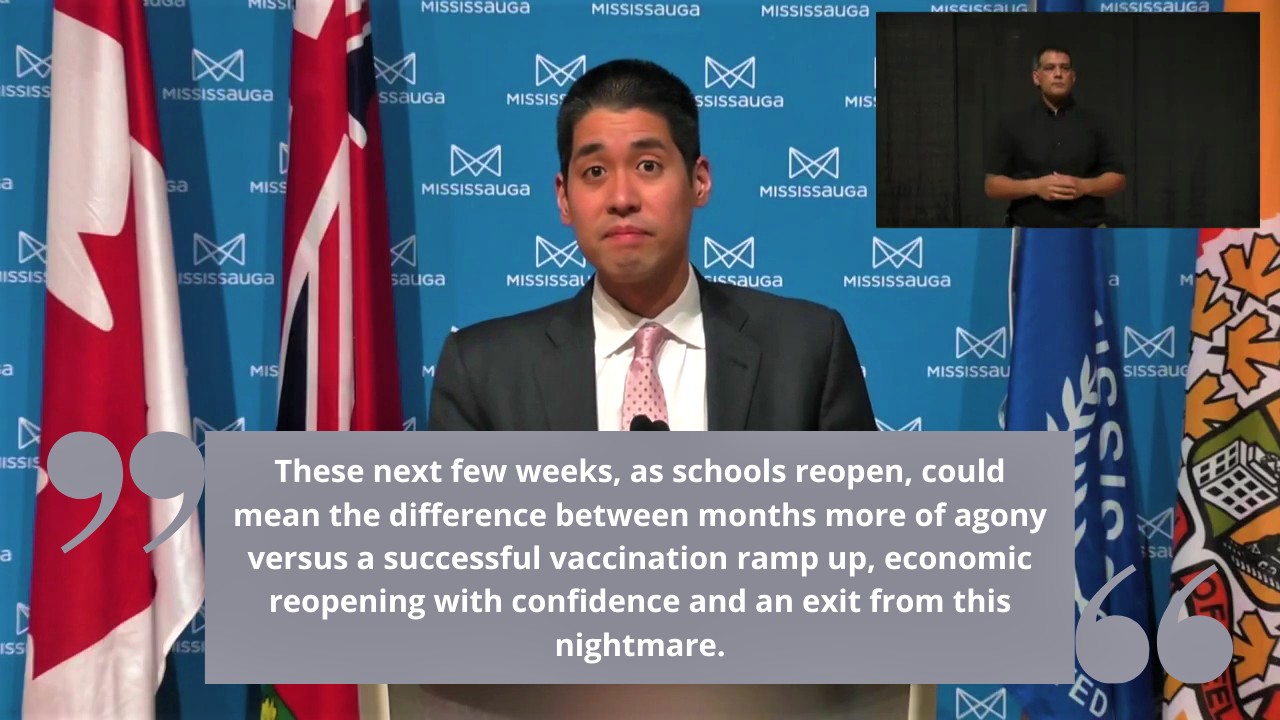
Crombie’s call to skip grey-zone restrictions doesn’t line up with public health guidelines
(Correction: An earlier version of the article stated a 2.5 percent test positivity for a jurisdiction is the upper limit of the Province's red category; it is the recommended bottom limit of the category and there is no upper limit to remain in the red zone. It was also stated that an infection incidence rate of 40 per 100,000 residents in a jurisdiction is the upper limit of the red category; there is no upper limit. The Pointer regrets the errors.)
In Peel’s most recent weekly epidemiological report, public health officials highlight an outbreak of the South African variant of the novel coronavirus, which was first detected in the region about a month ago.
Since the arrival in Peel of mutated versions of the novel coronavirus, those living in dense condos and apartments have been warned to be extra vigilant. The Centers for Disease Control and Prevention (CDC) says research shows the South African strain and the other variants of concern are more contagious than the earlier strain that caused the global pandemic, and though daily case numbers in Peel are declining health officials warn against relaxing personal safety measures.
“These variants seem to spread more easily and quickly than other variants, which may lead to more cases of COVID-19. An increase in the number of cases will put more strain on health care resources, lead to more hospitalizations, and potentially more deaths,” the CDC states.
The outbreak occurred in a Mississauga condo building and at least six residents contracted the B.1.351 strain while another two appear to have tested positive (confirmation was pending as of the report’s release on Friday). Onsite testing of almost 500 people at the condo on February 15 showed three other individuals had COVID-19. The cases were detected in five residential units on three floors of the building.
Public health officials say the source of the outbreak can not be determined.
The lack of information should serve as a warning to all Peel residents. As daily case numbers have declined over the past month, and the region is set to move out of the current stay-at-home-order on March 9, there are still many unknowns, public health officials have stated.
Ontario’s chief medical officer of health, Dr. David Williams, announced on February 1 that the province’s first known detection of the B.1.351 strain was in Peel. The male resident had no travel history or known contacts that would have transmitted the virus.
The UK strain, known as B.1.1.7, has also been detected in Peel, including in at least two schools; one in each of the two major boards.
Comprehensive data on the impact of school reopenings in Peel two weeks ago are not yet available, and the rate of spread of new “variants of concern”, which mutated and came out of places such as the UK, Brazil and South Africa is still unknown.
The Region is asking all residents in multi-unit dwellings to be extra careful when using elevators, common areas such as laundry facilities and other parts of buildings, as the transmission of these potentially fast-spreading viral strains threatens to prolong the pandemic.
Despite the lack of conclusive data on the new strains in Peel, at a news conference on Wednesday, Mississauga Mayor Bonnie Crombie lobbied aggressively for Mississauga to skip the grey zone when the current stay-at-home-order is lifted afer March 8 (unless it’s extended). In the Province’s colour-coded reopening framework the grey category has the most restrictive measures. Crombie wants to instead have her city placed in the red zone, the next category down in the framework.

"You have a commitment from me that I will push for Mississauga into the red zone on March 9 unless we see a sudden increase in our numbers," Crombie said. She called for the whole region to be treated as one.
"The decision will ultimately be made by the province as usual as it always is, and we should know where we are headed by next Friday."
Peel’s chief medical officer, Dr. Lawrence Loh, asked the Province not to move Peel out from under the stay-at-home-order when most of Ontario, other than Peel, Toronto and North Bay-Parry Sound, was allowed to move back into the colour-coded framework last month.
Dr. Loh has expressed concern over the possible impact of students now back in classrooms, after they returned to schools February 16. The new epidemiological report, which he oversees, also expresses concern over the transmission of the viral strains. He wants enough time to see patterns in the data, before making short-sighted reopening decisions that could have severe long-term consequences. He has cautioned for a better-safe-than-sorry approach.
Crombie, meanwhile, along with many of her council colleagues, has expressed support for entrepreneurs who are being crippled by the ongoing shutdown.
"I realized how disappointing this was, particularly for our small businesses, who are anticipating reopening for in-person shopping," Crombie said at the press conference. "We know that the small businesses were never the main source of transmission. And you have sacrificed so much and I have been truly disappointed along with you."

Dr. Lawrence Loh has said this is not the time to rush into reopenings without proper data.
The main difference for retailers under the “Red-Control” category compared to the “Grey-Lockdown” category are allowable store capacities. The red zone allows 75 percent capacity for supermarkets and other stores that primarily sell groceries, convenience stores and for pharmacies; and 50 percent for all other retail, “including discount and big box retailers, liquor stores, hardware stores and garden centres,” according to the Province.
The grey zone allows 50 percent capacity for supermarkets and other stores that primarily sell groceries, convenience stores and for pharmacies; and 25 percent “for all other retail.”
Crombie’s pleas come as the Region is not yet out of the woods, and long before widespread community protection through vaccinations is expected to be achieved by the end of summer.
While data shows numbers in Peel improving, test positivity still stood at 5.8 percent as of February 20, which is more than twice the 2.5 percent rate recommended before a region can be moved into the red zone, which the mayor is advocating for.
The infection incidence rate per 100,000 residents is also still far above the recommended threshold to be moved into the red category. As of February 20, Peel’s rate was at 88.3, while the red-zone criteria is 40 and above (the Province has not set an upper limit for the red category).
Email: [email protected]
Twitter: @JoeljWittnebel
COVID-19 is impacting all Canadians. At a time when vital public information is needed by everyone, The Pointer has taken down our paywall on all stories relating to the pandemic and those of public interest to ensure every resident of Brampton and Mississauga has access to the facts. For those who are able, we encourage you to consider a subscription. This will help us report on important public interest issues the community needs to know about now more than ever. You can register for a 30-day free trial HERE. Thereafter, The Pointer will charge $10 a month and you can cancel any time right on the website. Thank you.
Submit a correction about this story


